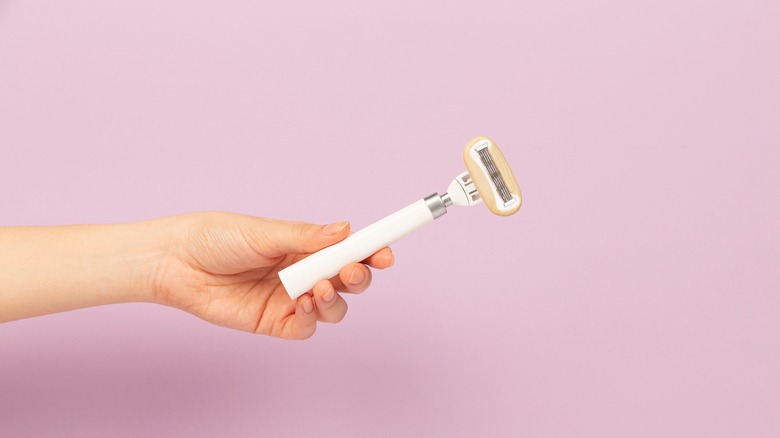Sharing A Razor With Your Partner? Here's Why It's Not A Good Idea
While the decision to remove body hair is a personal choice, if you do shave, there are likely a few shaving mistakes you never knew you were making. For example, you should never shave if you have an ingrown hair, an open wound, or a rash of any kind. To get the best possible shave, you should hydrate and exfoliate the skin before using a razor. Likewise, ensure that you are shaving in the opposite direction of hair growth.
Using a lubricant like shaving cream is also a must. If you don't have that on hand, there are shaving cream substitutes you've never thought of. This includes coconut oil, body wash, and hair conditioner. In addition, moisturizing before and after shaving will reduce itchiness and other possible discomforts. However, the golden rule when it comes to shaving is to always use your own razor. Perhaps you've been in a situation where you forgot to replace your razor blade or you forgot your razor completely. Your first instinct will likely be to grab your partner's razor or whoever lives with you, such as a roommate or sibling. However, you should think twice before doing this. As Joyce Imahiyerobo-Ip, M.D. put it, "Sharing razors is a major no-no from a dermatologist's perspective" (via Shape).
Sharing a razor can have major consequences
So what's the big deal with sharing razors? Dermatologist Rachel Nazarian, M.D., explained to Well+ Good that it can cause major health concerns. "The razor collects bacteria as it's pulled along the skin, and unless it's sterilized between uses, it actually spreads the bacteria to the next person," she said. Simply put, cross-contamination can occur, leading to the person borrowing the razor to develop an infection due to the small cuts and scratches caused by shaving. This compromises the skin barrier, allowing bacteria like staph, viruses, and more to get in.
If you share a razor, you're more likely to develop folliculitis or inflammation of the hair follicles. In this case, the skin may appear red, itchy, and bumpy. At-home folliculitis treatments include applying warm compresses on the skin and using over-the-counter antibiotic ointments. If the pain becomes too much or you have a fever, visit your doctor, as the folliculitis has likely evolved into an infection. Other infections or viruses resulting from sharing a razor include yeast, fungi, herpes, and warts. In addition, it's possible to develop diseases such as HIV and Hepatitis C and B, according to The Royal Women's Hospital.
Changing your razor's blade regularly is also important
People don't replace their razor blades as often as they should, which can lead to problems for you and the razor's primary user. Leslie Tessler, founder of the shaving brand Hanna, told Well+ Good, "From a hygienic perspective, it's an absolute nightmare, especially with plastic cartridges." She added, "Just think about the fact that you've got three, four, five blades, with plastic in between, sitting in a humid environment for long periods of time... We've spoken with many gynecologists who often see bacterial infections as a result."
If you shave daily, experts recommend you change your blade every one to two weeks. If you shave every other day, change it every two to three weeks. And if you shave twice a week, changing it every four to six weeks is fine. Likewise, shaving with a dull or old razor, whether yours or someone else's, can be equally damaging as it also makes you more likely to contract an infection and even break down skin collagen.
Stick to using a new, clean razor that's all your own for the safest shaving experience.


